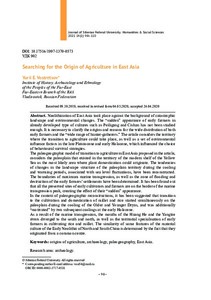Показать сокращенную информацию
Searching for the Origin of Agriculture in East Asia
| Автор | Vostretsov, Yurii E. | en |
| Автор | Вострецов, Ю.Е. | ru_RU |
| Дата внесения | 2020-05-25T01:58:08Z | |
| Дата, когда ресурс стал доступен | 2020-05-25T01:58:08Z | |
| Дата публикации | 2021-01 | |
| URI (для ссылок/цитирований) | https://elib.sfu-kras.ru/handle/2311/135259 | |
| Аннотация | Neolithization of East Asia took place against the background of catastrophic landscape and environmental changes. The “sudden” appearance of early farmers in already developed type of cultures such as Peiligang and Cishan has not been studied enough. It is necessary to clarify the origins and reasons for the wide distribution of both early farmers and the “wide range of hunter-gatherers.” The article considers the territory where the transition to agriculture could take place, as well as a set of environmental influence factors in the late Pleistocene and early Holocene, which influenced the choice of behavioural survival strategies. The paleogeographic model of transition to agriculture in East Asia proposed in the article, considers the paleoplain that existed in the territory of the modern shelf of the Yellow Sea as the most likely area where plant domestication could originate. The tendencies of changes in the landscape structure of the paleoplain territory during the cooling and warming periods, associated with sea level fluctuations, have been reconstructed. The boundaries of maximum marine transgression, as well as the zone of flooding and destruction of the early farmers’ settlements have been determined. It has been found out that all the preserved sites of early cultivators and farmers are on the border of the marine transgression peak, creating the effect of their “sudden” appearance. In the context of paleogeographic reconstructions, it has been suggested that transition to the cultivation and domestication of millet and rice started simultaneously on the paleoplain during the cooling of the Older and Younger Dryas, and was additionally “motivated” by two subsequent coolings at the early Holocene. As a result of the marine transgression, the mouths of the Huang He and the Yangtze rivers diverged to the south and north, as well as the territorial specialisation of early farmers in cultivating rice and millet. The similarity of some features of the material culture of the Early Neolithic of North and South China is determined by the fact that they originated from a common centre | en |
| Аннотация | Неолитизация Восточной Азии происходила на фоне катастрофических ландшафтно-климатических изменений. «Внезапное» появление ранних земледельцев в уже развитом виде типа Пелиган и Сишань изучалось недостаточно. Необходимо прояснить истоки появления и причины широкого распространения как ранних земледельцев, так и «широкого спектра охотников-собирателей». Рассмотрена территория, на которой мог проходить переход к земледелию, а также комплекс факторов давления окружающей среды в конце плейстоцена – начале голоцена, повлиявших на выбор поведенческих стратегий выживания. Предлагаемая в статье палеогеографическая модель перехода к земледелию в Восточной Азии рассматривает палеоравнину, существовавшую на современном шельфе Желтого моря, как наиболее вероятную область, где могла начаться доместикация растений. Реконструированы тенденции изменения ландшафтной структуры территории палеоравнины в процессе похолоданий и потеплений климата, сопряженных с колебаниями уровня моря. Определены границы максимума трансгрессии моря и зона затопления и разрушения поселений ранних земледельцев. Выяснено, что все сохранившиеся памятники ранних культиваторов и земледельцев находятся по обрамлению границ пика трансгрессии моря, создавая эффект их «внезапного» появления. В контексте палеогеографических реконструкций выдвинуто предположение, что переход к культивации и одомашниванию просяных и риса начался одновременно на палеоравнине в период похолоданий Древнего и Позднего Дриаса и дополнительно «мотивировался» двумя последующими похолоданиями в начале голоцена. В результате трансгрессии моря произошло расхождение устьев рек Хуанхэ и Янцзы в южном и северном направлении и, соответственно, территориальная специализация ранних земледельцев на культивацию риса и просяных. Сходство некоторых черт материальной культуры раннего неолита Северного и Южного Китая обусловлено происхождением из общего центра | ru_RU |
| Язык | en | en |
| Издатель | Сибирский федеральный университет. Siberian Federal University | en |
| Тема | origins of agriculture | en |
| Тема | archaeology | en |
| Тема | paleogeography | en |
| Тема | East Asia | en |
| Тема | происхождение земледелия | ru_RU |
| Тема | археология | ru_RU |
| Тема | палеогеография | ru_RU |
| Тема | Восточная Азия | ru_RU |
| Название | Searching for the Origin of Agriculture in East Asia | en |
| Альтернативное название | В поисках происхождения земледелия в Восточной Азии | ru_RU |
| Тип | Journal Article | en |
| Контакты автора | Vostretsov, Yurii E.: Institute of History, Archaeology and Ethnology of the Peoples of the Far-East Far-Eastern Branch of the RAS Vladivostok, Russian Federation; vost54@mail.ru; vost54@mail.ru | en |
| Контакты автора | Вострецов, Ю.Е.: Институт истории, археологии и этнографии народов Дальнего Востока, Дальневосточное отделение РАН Российская Федерация, Владивосток | ru_RU |
| Страницы | 98–110 | |
| DOI | 10.17516/1997-1370-0573 | |
| Журнал | Журнал Сибирского федерального университета. Гуманитарные науки. Journal of Siberian Federal University. Humanities & Social Sciences; 2021 14 (1) | en |

